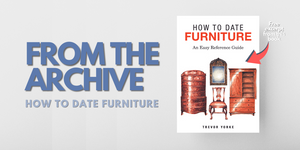FREE Chapter from How to Date Furniture

A Brief History of Beds & Bedrooms
The bedroom has not always been the warm and private retreat filled with a wide range of furniture we are familiar with today.
Originally the lord of the manor would sleep on the floor of his hall along with his household. It was only in the later medieval period that private chambers became common so he could escape the noise and smell.
Even in the Tudor period these would have seemed bare by modern standards with the room dominated by a four-poster bed, its bed hangings or curtains helping to keep out the cold draughts and give the occupants some privacy.
In some late-17th century country houses, the bedchamber was positioned at the end of a long straight range of rooms called an enfilade and was designed so the owner could receive friends and guests here, a fashion which continued into the following century. By this date, the beds in the finest houses had developed from the richly carved oak pieces of the Tudor period into magnificent displays of upholstered bed hangings on the finest state beds.
An alternative fashion was to set the bed within an alcove, which could be curtained off so it did not require a canopy on posts. In the late 18th century, beds with a short canopy fitted with draped fabrics, known as a half tester, became fashionable, but it was not until the 19th century when the bedroom had become a private reserve of the family that conventional wooden, iron and brass bed frames with just a head and footboard became standard.
Until the mid-18th century bedroom furniture was usually limited to chests and linen presses. It was only around this date that washing daily became fashionable and washstands made an appearance. Dressing tables were literally a table covered by a cloth in many households; purpose-made pieces with drawers and a mirror only became common in the later Georgian period.
The modern wardrobe evolved in the early 19th century from the linen press which continued to be available alongside it. It was therefore not until the Victorian period that wardrobes, chests of drawers, dressing tables and bedside cabinets became standard fittings in middle and upper class homes and these pieces were usually sold as a suite in a matching style.
This chapter is taken from How to Date Furniture
- Rory Batho







Comments 0